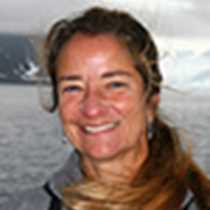At the northeast corner of Kupreanof Island, where water from Frederick Sound meets up with water from Chatham Strait and Stephens Passage, we found many humpback whales feeding. Sometimes a whale surfaced with its mouth wide open, and we could see pink on the roof of the whale's mouth! There were humpbacks blowing and diving all around us. At least a dozen animals were feeding close by the ship.
When humpback whales dive, they usually raise their tail flukes out of the water, and the coloration on the underside of the flukes is slightly different on each animal. The color can range from totally black to totally white, and additionally, humpbacks will usually accumulate scars on top of this basic pigmentation pattern. After watching the whales for a few minutes, we came to recognize some of the animals. One of the whales had white flukes, one had totally black flukes, and the other had flukes that were half-black, half-white. Here is a close view of the whale we nicknamed "White" while we watched it feeding in the late afternoon. Researchers have thousands of these identification photographs just like this, and they have proved invaluable in tracking the movements of individual humpbacks, and learning about their behaviors.




